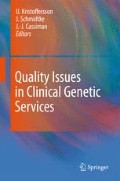Key Points
• All commercial providers of genetic tests for common multifactorial diseases (CMD), and most, if not all, large scale genetic epidemiological projects on CMD, claim a potential diagnostic impact of the currently available information on the respective disease-gene association.
• A genetic susceptibility test for a CMD may be useful in a public health context, i.e. trigger one or more preventive measures at an economically sensible level, if the (relative) risk of a sufficiently frequent genotype is sufficiently high and if carriers of that risk genotype benefit enough from the available preventions.
• The relative risks of genetic susceptibility factors for CMD must be quantified in large studies before their clinical utility can be valuated. Currently, such information is either scanty or discouraging. The vast majority of known relative genetic risks for CMD are smaller than 1.5 and are therefore unlikely to trigger preventive measures.
• The most promising candidates for CMD causation are mildly deleterious mutations, which are inherently likely to occur at sub-polymorphic frequency owing to selection. These variants will therefore be inefficient to screen for at a population-wide level.
• Information about interaction between genetic risk factors for CMD is a prerequisite for risk profiling, i.e. the joint assessment of multiple risk factors at a time, to be appropriate and advantageous. Currently, however, such information is lacking for most if not all CMD for which genetic tests are being offered.
Access this chapter
Tax calculation will be finalised at checkout
Purchases are for personal use only
Notes
- 1.
Since rno-ryes = f ⋅ (rno,g-ryes,g) + (1-f) ⋅ (rno,ng-ryes,ng), where f denotes the population frequency of susceptibility genotype g, formula 2 can only apply if (1) f is not too large and (2) rno,g-ryes,g >> rno,ng-ryes,ng. The second condition can be rearranged to read rno,g-rno,ng >> ryes,g-ryes,ng, which implies that rno,g-rno,ng, but not ryes,g-ryes,ng, must be substantially larger than zero.
References
Bodmer W, Bonilla C. Common and rare variants in multifactorial susceptibility to common diseases. Nat Genet 2008; 40: 695–701.
Carlsten C, et al. Glutathione S-transferase M1 (GSTM1) polymorphisms and lung cancer: A literature-based systematic HuGE review and meta-analysis. Am J Epidemiol 2008; 167: 159–774.
Ioannidis JPA, et al. Replication validity of genetic association studies. Nat Genet 2001; 29: 306–309.
Ioannidis JPA. Why most published research findings are false. PLoS Med 2005; 2: e124.
Janssens AC, et al. A critical appraisal of the scientific basis of commercial genomic profiles used to assess health risks and personalize health interventions. Am J Hum Genet 2008; 82: 593–599.
Kryukov GV, Pennacchio LA, Sunyaev SR. Most rare missense alleles are deleterious in humans: implications for complex disease and association studies. Am J Hum Genet 2007; 80: 727–739.
National Centre for Priotity Setting in Health Care. Resolving health care’s difficult choices. Survey of priority setting in Sweden and an analysis of principles and guidelines on priorities in health care. PrioriteringsCentrum, Linköping, 2008.
Ordovas JM, et al. Polyunsaturated fatty acids modulate the effects of the APOA1 G-A polymorphism on HDL-cholesterol concentrations in a sex-specific manner: the Framingham Study. Am J Clin Nutr 2002; 75: 38–46.
Zimmern RL, Kroese M. The evaluation of genetic tests. J Public Health (Oxford) 2007; 29: 246–250.
Acknowledgement
I would like to thank Michael Nothnagel and Timothy T. Lu, Kiel, for helpful comments on this manuscript
Author information
Authors and Affiliations
Corresponding author
Editor information
Editors and Affiliations
Rights and permissions
Copyright information
© 2010 Springer Science+Business Media B.V.
About this chapter
Cite this chapter
Krawczak, M. (2010). Clinical Validity and Utility of Genetic Testing in Common Multifactorial Diseases. In: Kristoffersson, U., Schmidtke, J., Cassiman, J. (eds) Quality Issues in Clinical Genetic Services. Springer, Dordrecht. https://doi.org/10.1007/978-90-481-3919-4_16
Download citation
DOI: https://doi.org/10.1007/978-90-481-3919-4_16
Published:
Publisher Name: Springer, Dordrecht
Print ISBN: 978-90-481-3918-7
Online ISBN: 978-90-481-3919-4
eBook Packages: Biomedical and Life SciencesBiomedical and Life Sciences (R0)

